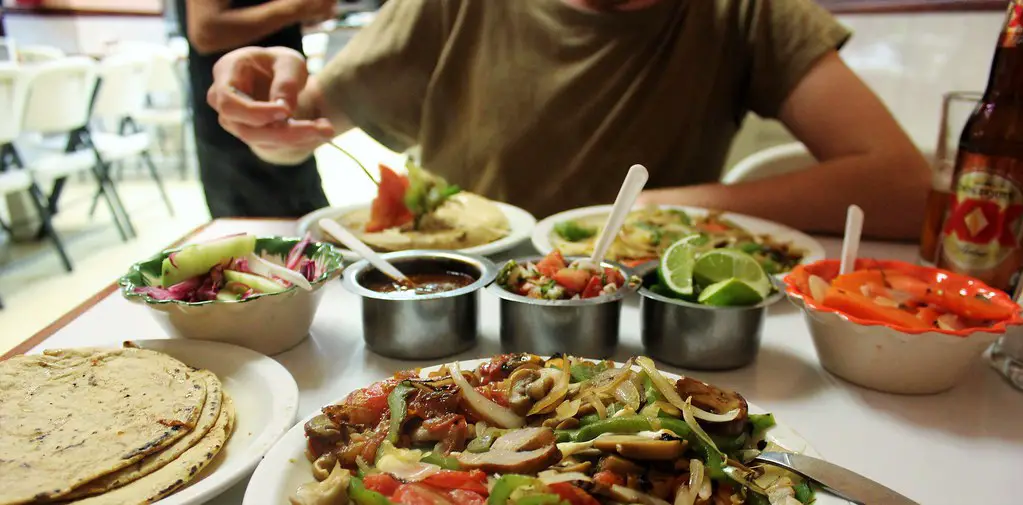Table of Contents
One Oaxacan Dining Experience is No Better Nor Richer than the Other
With its world renowned reputation for gastronomic excellence, Oaxaca has become a mecca for food aficionados ranging from internationally acclaimed chefs seeking to expand and enhance their hometown bistro offerings, to visitors with little more than a passion for indulging in perhaps the best cuisine the Americas have to offer.
The multitude of restaurants, from the finest white linen establishments to the quaintest of roadside eateries, and everything in between, offers travelers an opportunity to experience the most unusual yet delectable of flavor combinations. And the melding of ingredients from Old World Spain with those of pre-Hispanic indigenous origin produces unparalleled richness.
Fiestas in Oaxaca Provide an Opportunity to Dine with The Locals
Restaurant reviews and recommendations lead tourists to the city to only one dimension of the array of Oaxaca’s culinary delights. So consider grabbing any opportunity to participate in local events and fiestas whenever the opportunity presents. Accept any and all invitations from native Oaxacans, both in the city and villages, and hope to experience:
- the highly ritualistic preparation of goat, sheep or beef in an in-ground, earth-covered oven;
- an afternoon meal starting off with an oversized bowl of steamy, frothy hot chocolate with a small loaf of egg bread as dipper, mole negro waiting in the wings;
- a salsa roja so scrumptious that learning ground gusano worm is the defining ingredient fails to quash the desire for more; or
- the commencement of comida with an appetizer plate of quesillo (Oaxacan string cheese), chicharrón (pork cracklings), rajas (marinated chili, onion and carrot, with clove essence), and of course fried grasshoppers.
Indulging in the Town Marketplaces in the Central Valleys of Oaxaca
While the vast majority of salsas and moles, appetizers and finger foods, and main courses and desserts are indeed available in restaurants, part of the allure of Oaxaca is the ability to get out of the city and into village marketplaces on day tours, where a plethora of foodstuffs and beverages can be sampled. The four main rural marketplace days are Sunday in Tlacolula, Wednesday in Etla, Thursday in Zaachila, and Friday in Ocotlán.
No less than eight varieties of tamales are available at the Etla marketplace. All markets boast drinks such as chilacayota, a spaghetti type of squash, boiled and sweetened with brown sugary piloncillo; and tejate, a ritual drink made of corn boiled with ash, cacao and its flower, and the seed of the mamey fruit. Vendors at Ocotlán and Tlacolula produce pulque, the fermented “honey water” of the pulquero variety of agave plant.
The aroma of charcoal grilled chicken entices, while the sight of a bubbling cauldron of barbacoade borrego (traditionally prepared mutton) piques one’s curiosity … as does the gelatinous corn-based dessert known as nicuatole, surprisingly only moderately sweet. Each town has more than one rustic chocolate production facility, where one can buy ingredients – roasted cacao beans, almonds, cinnamon and unrefined sugar – and have them milled into chocolate to exacting personal specifications.
There are two exceptional restaurants along Highway 190, along the traditional touring route encompassing Santa María el Tule, Teotitlán del Valle and Tlacolula.
Restaurants of Oaxaca versus Bars and Roadside Comedors
It would be easy to enumerate a selection of restaurants in Oaxaca patronized predominantly by tourists, and then determine “the best” based on an ambiance which breeds familiarity and comfort. But many travelers visit the region to experience the culture. Food prepared and served as it was before the first tourists arrived, by and for the native population, is part of getting to know the real Mexico.
Hence, the comidas served at the tiny roadside eatery known as El Tigre, or snack foods accompanying drinks at suburban local haunt El Faro, are no less fresh and complex in ingredient combination, than those enjoyed at downtown institutions such as Los Danzantes, Casa Oaxaca and La Biznaga. Omitting one type in favor of the other does no justice to one’s desire to thoroughly enjoy, and indulge in Oaxaca.

It’s not a matter of where, but when. Time is precious and my time spent living and experience the cultures of this world is what I lust for. This is why I created this website, to share true, genuine experiences and not just typical touristy info. Travel, the love of coffee, and food!
